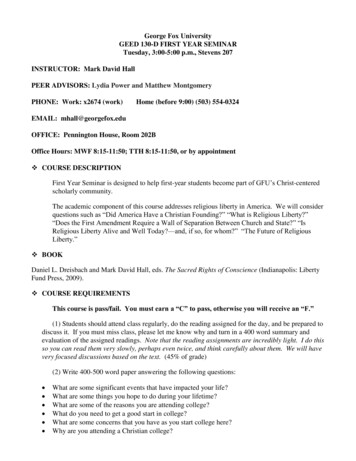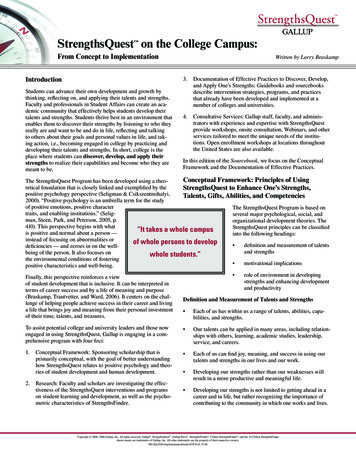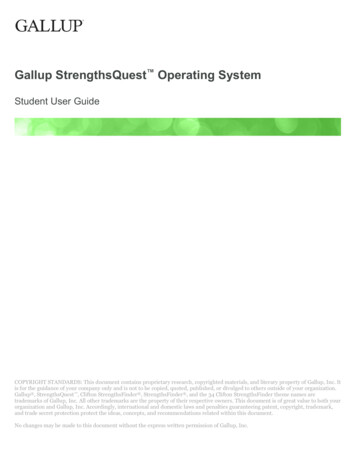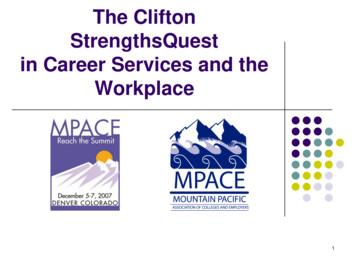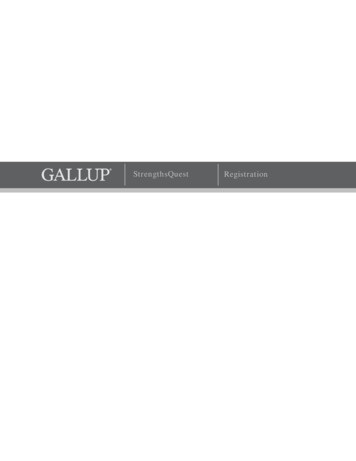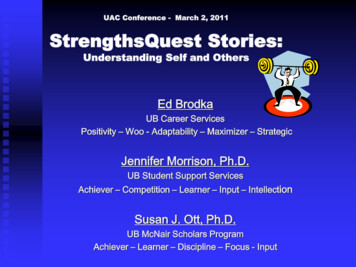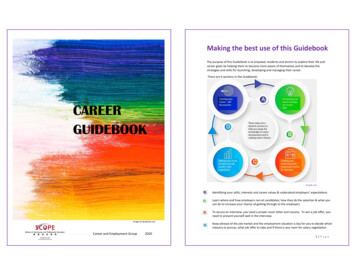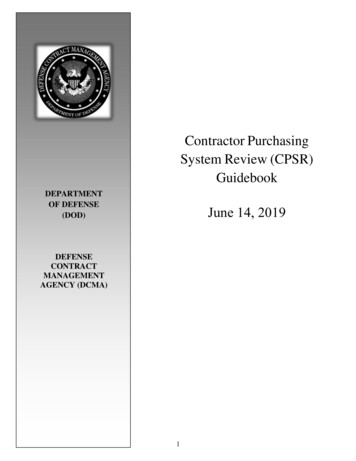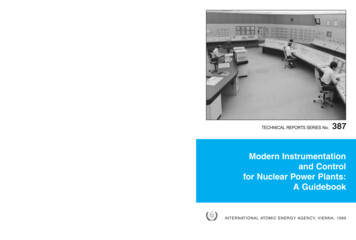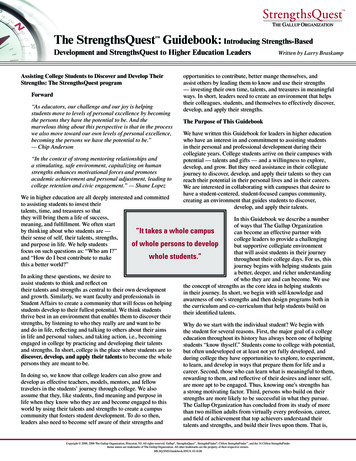
Transcription
The StrengthsQuest Guidebook: Introducing Strengths-Based Development and StrengthsQuest to Higher Education LeadersAssisting College Students to Discover and Develop TheirStrengths: The StrengthsQuest programForward“As educators, our challenge and our joy is helpingstudents move to levels of personal excellence by becomingthe persons they have the potential to be. And themarvelous thing about this perspective is that in the processwe also move toward our own levels of personal excellence,becoming the persons we have the potential to be.”— Chip Anderson“In the context of strong mentoring relationships anda stimulating, safe environment, capitalizing on humanstrengths enhances motivational forces and promotesacademic achievement and personal adjustment, leading tocollege retention and civic engagement.” — Shane Lopez Written by Larry Braskampopportunities to contribute, better mange themselves, andassist others by leading them to know and use their strengths— investing their own time, talents, and treasures in meaningfulways. In short, leaders need to create an environment that helpstheir colleagues, students, and themselves to effectively discover,develop, and apply their strengths.The Purpose of This GuidebookWe have written this Guidebook for leaders in higher educationwho have an interest in and commitment to assisting studentsin their personal and professional development during theircollegiate years. College students arrive on their campuses withpotential — talents and gifts — and a willingness to explore,develop, and grow. But they need assistance in their collegiatejourney to discover, develop, and apply their talents so they canreach their potential in their personal lives and in their careers.We are interested in collaborating with campuses that desire tohave a student-centered, student-focused campus community,creating an environment that guides students to discover,develop, and apply their talents.We in higher education are all deeply interested and committedto assisting students to invest theirtalents, time, and treasures so thatthey will bring them a life of success,meaning, and fulfillment. We often startby thinking about who students are —“It takes a whole campustheir sense of self, their talents, strengths,of whole persons to developand purpose in life. We help studentsfocus on such questions as: “Who am I?”whole students.”and “How do I best contribute to makethis a better world?”In asking these questions, we desire toassist students to think and reflect ontheir talents and strengths as central to their own developmentand growth. Similarly, we want faculty and professionals inStudent Affairs to create a community that will focus on helpingstudents develop to their fullest potential. We think studentsthrive best in an environment that enables them to discover theirstrengths, by listening to who they really are and want to beand do in life, reflecting and talking to others about their aimsin life and personal values, and taking action, i.e., becomingengaged in college by practicing and developing their talentsand strengths. In short, college is the place where students are todiscover, develop, and apply their talents to become the wholepersons they are meant to be.In doing so, we know that college leaders can also grow anddevelop as effective teachers, models, mentors, and fellowtravelers in the students’ journey through college. We alsoassume that they, like students, find meaning and purpose inlife when they know who they are and become engaged to thisworld by using their talents and strengths to create a campuscommunity that fosters student development. To do so then,leaders also need to become self aware of their strengths andIn this Guidebook we describe a numberof ways that The Gallup Organizationcan become an effective partner withcollege leaders to provide a challengingbut supportive collegiate environmentthat will assist students in their journeythroughout their college days. For us, thisjourney begins with helping students gaina better, deeper, and richer understandingof who they are and can become. We usethe concept of strengths as the core idea in helping studentsin their journey. In short, we begin with self-knowledge andawareness of one’s strengths and then design programs both inthe curriculum and co-curriculum that help students build ontheir identified talents.Why do we start with the individual student? We begin withthe student for several reasons. First, the major goal of a collegeeducation throughout its history has always been one of helpingstudents “know thyself.” Students come to college with potential,but often undeveloped or at least not yet fully developed, andduring college they have opportunities to explore, to experiment,to learn, and develop in ways that prepare them for life and acareer. Second, those who can learn what is meaningful to them,rewarding to them, and reflective of their desires and inner self,are more apt to be engaged. Thus, knowing one’s strengths hasa strong motivating factor. Third, persons who build on theirstrengths are more likely to be successful in what they pursue.The Gallup Organization has concluded from its study of morethan two million adults from virtually every profession, career,and field of achievement that top achievers understand theirtalents and strengths, and build their lives upon them. That is,Copyright 2000, 2006 The Gallup Organization, Princeton, NJ. All rights reserved. Gallup , StrengthsQuest , StrengthsFinder , Clifton StrengthsFinder , and the 34 Clifton StrengthsFindertheme names are trademarks of The Gallup Organization. All other trademarks are the property of their respective owners.MS.SQ.SND.Guidebook.ENUS.10.16.06
persons are more apt to perform at levels of excellence if theyare using and applying their strengths in their engagement. ChipAnderson states it this way: “The best of the best build their livesaround their talents,” and “The best of the best invent ways ofdeveloping and applying strengths in areas where they want toimprove, achieve, and become more effective” (2004, p. 7).Although we begin with students, we do not wish to stop there.We recognize the importance of the social environment — allthe members of the college campus community — for thestudents. We consider the development of all members — staff,leaders, and faculty on the college campus — to be important increating a culture and community that focuses on the strengthsof students. Thus, we offer programs not only for students butalso for those adults who are mentors and models for students intheir journey. As we describe later, we offer programs for staffdevelopment using the same basic strategy — begin with helpingpeople better know who they are, particularly their strengths, andprovide programs and consultative services to assist them in theirdevelopment. You have a group of talents within you. Your greatest talents hold the key to high achievement,success, and progress at levels of personal excellence. Becoming aware of your talents builds confidence andprovides a basis for achievement. Learning how to develop and apply strengths willimprove your levels of achievement. Each of your talents can be applied in many areasincluding relationships, learning, academics, leadership,service, and careers. As you develop and apply strengths, your achievementswill increase and you will experience greater and morefrequent successes.Talents and StrengthsThe framework of the StrengthsQuest program is built on twoconcepts — talents and strengths. “A strength begins with atalent [ ] a naturally recurring pattern of thought, feeling,or behavior that can be productively applied. A great numberof talents naturally exist within you, and each of them is veryspecific [ ] Your talents empower you. They make it possiblefor you to move to higher levels of excellence and fulfill yourpotential. [ ] A talent represents a capacity to do something”(Clifton and Anderson, 2002, P. 6). All of us have a uniquecombination of talents that we can discover and develop to reachour potential.Theoretical Perspective of StrengthsQuestStrengthsQuest (SQ) has a theoretical foundation that is closelylinked to and exemplified by the Positive Psychology perspective(Seligman & Csikszentmihalyi, 2000). “Positive Psychologyis an umbrella term for the study of positive emotions, positivecharacter traits, and enabling institutions” (Seligman, Steen,Park, and Peterson, 2005, p. 410). This perspective begins withwhat is positive and normal about people — rather than focusingon their deficiencies or what is abnormal about them — andfocuses on a person’s wellbeing. “When we think about the fulldevelopment of students as persons, we must think in terms ofstudents developing strengths and learning how to apply them”(Anderson, 2004, p. 66).Thus, strengths are developed talents. Strengths are neitherinnate nor totally dependent on our heredity, but can bediscovered and developed so that they bring us stability andpersistence. “A strength is the ability to provide consistent,near-perfect performance in a given activity. [ ] strengths areproduced when talents are refined with knowledge and skill”(Clifton and Anderson, 2002, p. 8).This perspective is also grounded in good educational practices.“The strengths-based approach to maximizing student success,though grounded in historical educational practices, also isbuilt on two modern-day American educational principles:measurement of achievement, strengths, and determinantsof positive outcomes and individualization, educationalprofessionals spontaneously thinking about and acting upon theinterests and needs of each student and systematically makingefforts to personalize the learning experience” (Lopez, 2004,p. 1). It focuses on the environmental conditions of fosteringpositive characteristics and well being. The environment needsto be an “enabling environment,” i.e., a positive organization(Avolio and Luthans, 2005).We focus on talents and strengths because we argue that studentswho discover and develop their talents into strengths are ableto live and perform at a level of excellence — both in termsof career success and living a fulfilling life. Living at a levelof excellence in life is challenging, but it can be made morefulfilling and meaningful if one systematically and consistentlydevelops and uses his or her talents. Thus, we consider goodstudent development in terms of investing oneself — one’stalents, time, and treasures — into becoming the person onedesires and chooses to become. As Clifton and Andersonstate, “In a sense, the development and application of strengthsgenerates a feeling that you are fulfilling your personal destiny”(2002, p. 9). “Your strengths quest is a lifelong adventure. Eachof the three aspects — discovery, development, and application— will continue throughout your life. This exciting and fulfillingprocess should bring you a lifetime of great satisfaction and joy”(p. 14-5). Later we describe the structure of a campus-centeredinitiative to help students discover, develop, and apply theirstrengths.Finally, this perspective reinforces a view of student developmentthat is inclusive. It can be interpreted in terms of career successand by a life of meaning and purpose (Braskamp, Trautvetter,and Ward, 2006). It centers on the challenge of helping personsto achieve success in their career and living a life that bringsjoy and meaning from their personal investment of their time,talents, and treasures.More specifically, the SQ Program is based on six principles ofhuman nature and behavior (Chip Anderson, 2004). They are: Copyright 2000, 2006 The Gallup Organization, Princeton, NJ. All rights reserved. Gallup , StrengthsQuest , StrengthsFinder , Clifton StrengthsFinder , and the 34 Clifton StrengthsFindertheme names are trademarks of The Gallup Organization. All other trademarks are the property of their respective owners.MS.SQ.SND.Guidebook.ENUS.10.16.06
Benefits of Using the StrengthsQuest Program on YourCampusDo you desire to help students to increase their retentionto complete their coursework and graduate?If you desire to invest some of your resources into a SQ programon your campus, you can think of the return of this investmentby focusing on a number of benefits. From our experience withthe SQ program, campuses that have used SQ have asked thesequestions: What are the potential benefits for students? To whatend is this investment to achieve? Why invest in SQ? Assist students to become more self aware andacceptingDescription of the StrengthsQuest Talent AssessmentInstrumentAssist students to better understand others for who theyare and can becomeThe Gallup Organization has studied human behavior for morethan 70 years. Gallup has leveraged this deep understanding todevelop measurement tools, intervention and training programs,and consultative and advisory services with one single purposein mind: to help organizations and individuals maximize theirperformance. For college students, The Gallup Organizationhas designed an instrument and the accompanying talentdevelopment program that we refer to as StrengthsQuest.Assist students to use their strengths to increase theirlearning and gradesDo you wish to assist students to enhance theiracademic self efficacy, and to help them see their futurewith more hope, and to have a greater willingness toact on their strengths in college and beyond? Do youwish to help students better manage their weaknesses?Do you want to help students to be more involved inengaged learning? The SQ instrument — the Clifton StrengthsFinder — consistsof 180 paired comparison items that are classified into 34groupings, called themes. Students take the instrument online,which takes about 30 minutes to complete. Students immediatelyreceive a report that lists their top five themes of talent in theorder in which they are most dominant for each individual. These34 themes are presented below.Assist students to understand their lives in terms ofcalling and perMaximizerAdaptabilityDisciplinePositivityAssist students to be team membersAnalyticalEmpathyRelatorDo you desire to provide experiences for students tobecome more effective and productive team members,and to help them learn how to reduce conflict in unicationIdeationSignificanceAssist students to become more effective leadersCompetitionIncluderStrategicDo you want to provide experiences and assistance inhelping students lead from their encyInputContextIntellectionDo you wish to help students to understand why andhow they can use their gifts and talents with and for apurpose? Assist students to more readily become members of thecampus communityDo you wish to find ways to get students to feel likecontributing members of the community, such ashelping advisors and faculty build better relationshipswith students?Do you desire to help students reduce bias andprejudices due to gender, race, and lifestyle, and toincrease their tolerance and acceptance of others? Assist students to improve their interpersonalrelationshipsDo you desire to help students in relating with theirroommate and college friends, parents, and adultauthority figures, and with their significant others?Do you desire to help students ask the question “Whoam I?” and to assist them in gains of better selfacceptance, self-identity, and individuality? Assist students with selecting and determining careerchoicesDo you wish to develop a more systematic approach tohelping students make decisions about their careers?We list 10 different potential benefits from an investment inthe SQ program to help you focus on why you may want toimplement the program on your campus. We encourage you toinitially ask yourself if each of these uses helps you achieve yourcampus mission and goals. Then, ask how the SQ Program canbe constructively integrated with the curricula and curricularactivities on your campus to help fulfill your campus missionand goals. Assist students to increase their expectations of stayingin school to graduate Copyright 2000, 2006 The Gallup Organization, Princeton, NJ. All rights reserved. Gallup , StrengthsQuest , StrengthsFinder , Clifton StrengthsFinder , and the 34 Clifton StrengthsFindertheme names are trademarks of The Gallup Organization. All other trademarks are the property of their respective owners.MS.SQ.SND.Guidebook.ENUS.10.16.06
More than two million people have taken the CliftonStrengthsFinder over the past several decades. This instrumenthas been analyzed for technical psychometric characteristics,including validity and reliability. A continuous program ofresearch is underway to determine the trustworthiness of SQand its appropriate uses. In this Guidebook we can state thatthe reliability of SQ is sufficient for its use as a tool to helpstudents in their development. Reliability refers to two relatedproperties. The first is the internal consistency of the 34 themes;to what extent are the items correlated with and interrelated withthe other items of the same theme? Is the theme a consistentintegrated portrayal of the given talents? In general, all 34themes have sufficient coherence to be used in helping studentsunderstand their talents. The second form of reliability is theconsistency of the themes, i.e. to what extent are studentsanswering the items in a similar way over extended periods oftime? Students are somewhat consistent in their response overa six-week period, according to one study of college students(Schreiner, 2005).of strengths, and provide them with insights andstrategies on how they can apply their talents andstrengths in academics, careers, and life. Students participate in this interactive Web site to learnmore about their strengths, engage in selected learningmodules, and participate in a discussion board. -first-year experience classesrelationship-buildingleadership developmentlearning communitiesfraternity and sorority groupsstrengths-based advisingstrengths-based teachingcareer counselingprofessional mentoringpeer mentoringstrengths-based academic classescalling and purposeThese four interconnected activities of the SQ program allshare a commonality — campus educators need to providea challenging but supportive community that facilitates the“drawing out” of the students’ inner talents, strengths, and gifts.Rather than thinking in terms of pouring “things” into studentsto reduce their deficiencies, they instead are engaged in helpingstudents build on and nurture their interior selves — theirvalues, talents, and sense of self. Leaders consciously connectthe inner and outer life of students, linking being and doing andmaximizing how being and doing feed off each other. Thus,leaders focus on creating the environment in which mentorsand models provide the type of learning and developmentenvironment that will maximally discover, develop, and applyone’s talents.Using a SQ Program to Foster Student DevelopmentHelping students discover, develop, and apply their talentsrequires a total campus strategy. The Gallup Organizationhas designed the StrengthsQuest program to include fourmajor components. The first three are services provided to thestudent under the direction and guidance of the local campusleaders. The last one is a unique set of activities designed andimplemented by each campus in consultation with Gallup.How Colleges Are Currently Using SQA number of institutions are currently using the SQ program intheir curricular and co-curricular programs to assist students indiscovering, developing, and applying their talents. We presenthere a sample of the wide range of practices and programs thatcampuses are now engaged in with SQ. Many of these campusesbegan their programs with a pilot program (e.g. leaders in studentgovernment use the SQ in their leadership retreats), and withmore experience, the leaders of the campus often expanded theSQ program to include more students and integrate the programinto more campus life activities and academic programs, like afreshmen year experience course.Discover talents through the assessment.Students take an online talent assessment instrument,the Clifton StrengthsFinder, which reveals their greatestareas of talent Campus programsIn collaboration with Gallup, college campus leadersdesign and develop curricular and co-curricularprograms (workshops, retreats, ongoing trainingsessions) to engage students in the discovery,development, and application of their strengths. Programcomponents include:The other major important characteristic is the validity of theresults. Validity refers to the level of confidence one can have ofthe usefulness of the results for given purposes. What differencedoes it make for a student to know the results of her taking theSQ talent assessment? Of what use is it? Determining the validityof the results is an ongoing process, and is multifaceted. Galluphas conducted several studies to determine the relationship ofSQ scores with measures of career interests, such as the HollandVocation Preference Inventory and personality inventories suchas the California Personality Inventory and the 16PF (Schreiner,2006) to study its construct validity. Gallup has also investigatedthe positive impact on student participation in a SQ programon college retention. It has concluded that the effect of advisingstudents with a strengths-based perspective, using the SQ as theprovider of information about student abilities, results in moreeffective advising as measured by student satisfaction (Schreinerand Anderson, 2005). The StrengthsQuest Web siteDevelop strengths by reading about strengthsStudents read the book StrengthsQuest: Discover andDevelop Your Strengths in Academics, Career, andBeyond by Donald Clifton and Chip Anderson, withLaurie Schreiner (2006) to help them understand theirtalents, direct them in their search for and development Copyright 2000, 2006 The Gallup Organization, Princeton, NJ. All rights reserved. Gallup , StrengthsQuest , StrengthsFinder , Clifton StrengthsFinder , and the 34 Clifton StrengthsFindertheme names are trademarks of The Gallup Organization. All other trademarks are the property of their respective owners.MS.SQ.SND.Guidebook.ENUS.10.16.06
The following is a partial list of participating institutions:institutional mission is to help students better understand theircalling and vocation in life (i.e., living a Christ-centered andpurposeful life by using their gifts to help others), they use SQ tohelp students develop a vocabulary so they can discuss and sharewith others their dreams, goals, and plans to use their gifts andstrengths. In short, it gives all students a common language tolearn more about themselves and their colleagues.Abilene Christian UniversityAndrews UniversityAzusa Pacific UniversityBaptist College of Health SciencesBaylor UniversityBethel Seminary, St PaulBiola UniversityBryant & Stratton College (for profit chain)California Baptist UniversityCalifornia Community CollegesCreighton UniversityDakota Wesleyan UniversityGeorge Washington University, Business SchoolGrand View CollegeHouston Baptist UniversityIndiana Wesleyan UniversityKaplan Higher Education Corp.Lee UniversityLetourneau CollegeLipscomb UniversityMaricopa Community Colleges (10 School System)National FFA OrganizationOhio State UniversityOral Roberts UniversityPepperdine UniversityRio Hondo CollegeSam Houston UniversitySeward County Community CollegeSimpson UniversityState Universities of New York (SUNY)Southern Methodist UniversityTemple UniversityTexas A&M College StationTexas A&M University - Corpus ChristiTexas Christian UniversityTexas State Technical College HarlingtonTexas Tech UniversityUniversity of KentuckyUniversity of MinnesotaUniversity of MissouriUniversity of Nebraska LincolnUniversity of PennsylvaniaUniversity of Texas ArlingtonUniversity Of Texas at San AntonioUniversity of Texas Austin, McCombs School of BusinessUniversity of Texas TylerWashington University (St. Louis)The University of Nebraska-Lincoln College of BusinessAdministration: Entering freshmen are active participants ina program designed by the college leaders, in consultation withGallup.Lee University in Cleveland, Tennessee has demonstrated a deepcommitment to making its campus a “strengths-based campus.”Incoming freshmen take the Clifton StrengthsFinder in anorientation course and then write a self-reflective paper on theirSignature Themes. Students also have the opportunity to talkto one of 18 faculty who volunteer to give an hour of their timeand attention to students about their strengths, often assistingthem to think through their career options and help them thinkin terms of a vocation in life — which for them is founded onmore deeply learning God’s design for them in their life. Thisvocation-oriented approach to a career is deeply embedded inthe culture of the campus. Faculty have also taken the CliftonStrengthsFinder and are engaged among themselves to learnmore about their own gifts and how to effectively use them tohelp students find their calling and vocation.At Florida International University, the staff in the Officeof Student Affairs has been using SQ since 2000. All theprofessional staff, which numbers in the hundreds, have takenthe Clifton StrengthsFinder and participated in workshops. SQhas been integrated in the Residence Life program in which allResidence Life Assistants engage in a series of sessions thatfocus on their talents and how they can use them in their workwith students. A select number of students in a number of Livingand Learning communities participate in programs that focus onleadership and team building.At Texas Tech University, some of the entering freshmen haveparticipated in the Freshman Seminar classes, in which theydiscovered and discussed their strengths in the seven-weekcourse. Through this engagement students have reported thatthey feel a greater sense of belonging to the campus. Manystudents who came from small towns in western Texas were ableto develop friendships based on their strengths. Last year TexasTech held a strengths-based career fair, in which a large numberof employers participated. Prior to the fair the university heldseminars for students to help them reflect on and identify theirstrengths so they could be better prepared in the interviews andto better understand themselves as they begin to embark on theircareer. They were able to understand that they possessed talentsand strengths that extended beyond the knowledge gained in theiracademic major. SQ turned out to be a great conversation starterfor these students.The following is a short summary of the programs at a fewinstitutions to illustrate the variety of programs already inprogress.Baylor University has been actively involved in the SQprogram for the past three years. All entering freshmen take theSQ during orientation week. During the first weeks they meet insmall groups, led by the staff of Student Affairs. Because their Copyright 2000, 2006 The Gallup Organization, Princeton, NJ. All rights reserved. Gallup , StrengthsQuest , StrengthsFinder , Clifton StrengthsFinder , and the 34 Clifton StrengthsFindertheme names are trademarks of The Gallup Organization. All other trademarks are the property of their respective owners.MS.SQ.SND.Guidebook.ENUS.10.16.06
Using the SQ Program to Foster Staff and FacultyDevelopmentOne of our major arguments for partnering with institutionsof higher education is that the campus environment is a veryimportant setting for students to discover, develop, and applytheir strengths. A campus needs to be student focused, creatingan environment that will foster student growth and development.One important way to accomplish this goal is to assist the entirecampus community — leaders, staff, and faculty — to apply theirknowledge and skills and gain valuable experience in focusingon their own personal strengths so they can best help others todevelop and use their talents. The Gallup Organization workscollaboratively with campuses in three major areas: Discover, develop, and apply talents — Gallup can helpleaders develop an individualized plan to enhance theireffectiveness as a colleague to others in their institution Lead with strengths — Gallup can help leaders createan environment that focuses on strengths-baseddevelopment. Leaders learn how to create a communitythat is based on strengths, first by learning about andleading from their own talents, then by learning how tolead based on the talents of those they lead. Create a strengths-based campus community — Gallupcan assist institutions (departments, colleges) how tolearn, plan, and implement strategies that enhance astrengths-based environmentResourcesAnderson, Edward C. (2004). StrengthsQuest: Curriculum Outline and Learning Activities. Princeton, NJ: Gallup OrganizationAvolio, B. J. and Luthans, F. (2005). The high impact leader. New York: McGraw-HillBraskamp, Larry A., Lois Calian Trautvetter, and Kelly Ward (2006). Putting studenst first: How colleges develop studentspurposefully. Bolton, MA: Anker Publishing.Clifton, Donald O. and Edward Anderson (2002). StrengthsQuest: Discover and develop your strengths in academics, career,and beyond. Washington, DC: The Gallup Organization.Lopez, Shane J. (2004). Naming and nurturing college students’ strengths. Princeton, NJ. The Gallup Organization.Schreiner, L. A. & E. Anderson (Fall 2005). Strengths-based advising: A new lens for higher education. NACADA Journal, 25,(2), 20-29.Seligman, M.E. & Csikszentmihalyi, M. (Eds). (2000). Positive psychology. (Special issue). American Psychologist.Seligman, M.E, T. A. Steen, N. Park, and C. Peterson (July-August 2005). Positive Psychology Progress: Empirical validation ofinterventions. American Psychologist. 60 (5), 410-421. Copyright 2000, 2006 The Gallup Or
The StrengthsQuest Guidebook: Introducing Strengths-Based Development and StrengthsQuest to Higher Education Leaders Written by Larry Braskamp Assisting College Students to Discover and Develop Their Strengths: The StrengthsQuest program Fo
